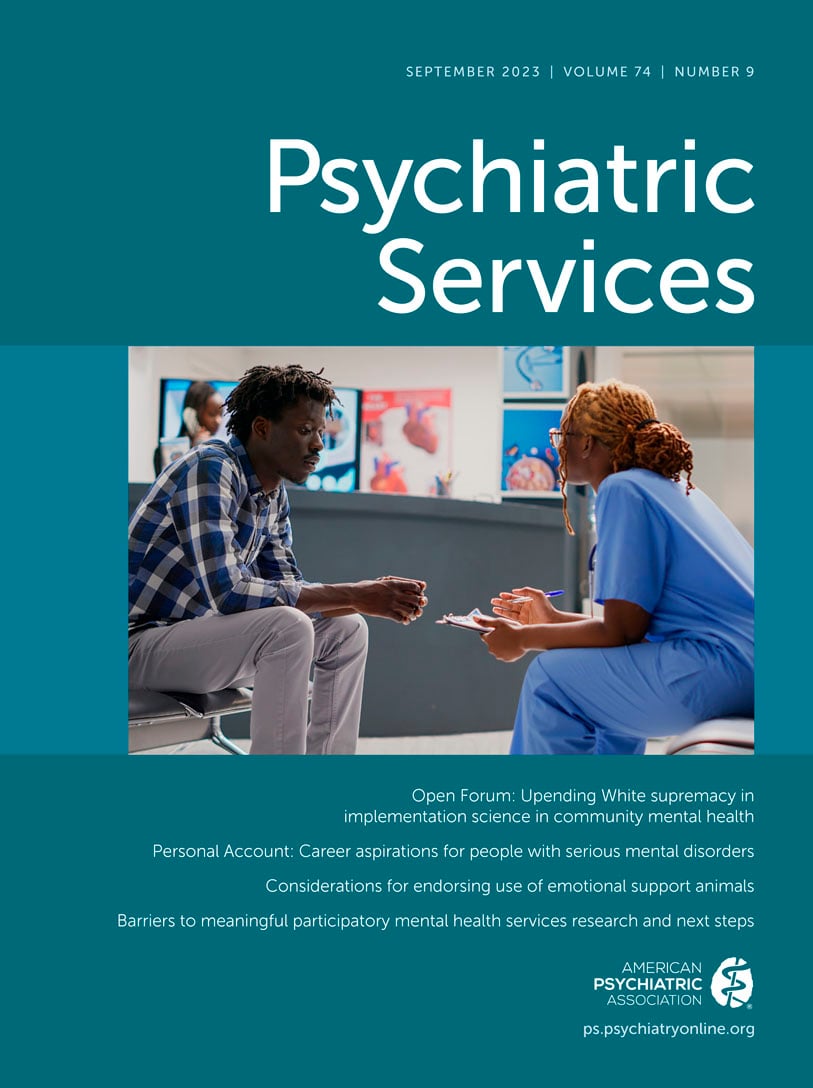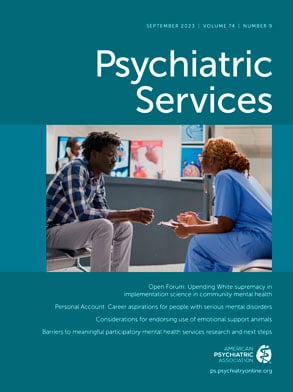Medical-psychiatry units (MPUs) first emerged in the United States in the 1980s to provide concurrent general medical and psychiatric care for hospitalized patients. Current estimates suggest that 2.7% of U.S. hospitals have an MPU (
1). These MPUs have developed mostly independently across the country and often fill a gap in local health systems that is widened by the arbitrary boundaries separating general medical from psychiatric care. Some MPUs are administered via internal medicine departments, whereas others are administered within psychiatry departments or psychiatric hospitals. The logistical decisions about where MPUs are housed or how they are configured may have an important impact on the types of patients who benefit from an MPU. For example, an MPU with nurses who have psychiatric and general medical training may be well situated to care for a patient with schizophrenia requiring acute general medical treatment, whereas an elderly patient with delirium may require different MPU resources and staff expertise.
In 2019, a group of clinicians and researchers came together at the annual conference of the Association of Medicine and Psychiatry to establish the MPU Consortium, with the goals of studying and disseminating information about the value of MPUs (
2). The initial step was to hold a series of meetings to collect information about existing MPUs, including their history, structure, and admission and exclusion criteria. The second step was to set priorities for investigation. MPU Consortium members felt that patients with severe mental illnesses, such as schizophrenia and other psychotic disorders, may have the most to gain from the kind of integrated care that MPUs can provide. Indeed, clinicians unfamiliar or uncomfortable with caring for patients with severe mental illnesses are prone to misattribution bias and tend to attribute symptoms and functional decline to psychiatric causes (
3), leading to missed opportunities for intervention (
4). Given that people with severe mental illnesses face a 20-year mortality gap because of more rapid progression of chronic general medical conditions such as heart disease, MPUs can offer a critical “moment of engagement” to coordinate and tailor care, laying important groundwork for improving health care trajectories in the community (
5).
We outline four steps to examine the potential of MPUs to improve outcomes, particularly for people with severe mental illnesses: first, take a patient-oriented approach to understanding the value of MPUs for treatment of severe mental illnesses; second, collect descriptive and observational data to facilitate consensus about key MPU components; third, collaborate with other MPUs to pool existing hospital data about patient outcomes and characteristics; and fourth, examine the influence of MPUs beyond the hospital setting for patients with severe mental illnesses.
Step 1: Take a Patient-Oriented Approach to Understanding the Value of MPUs
Attending to the priorities of a patient is not straightforward; clinicians make assumptions, and patients may not be empowered to articulate their experiences and preferences without proactive assessment. Moreover, although positive and therapeutic patient-clinician interactions have been shown to positively affect outcomes among people with severe mental illnesses (
6), methods to ensure optimal staff-patient interactions, especially regarding management of medical conditions, need further study. Similarly, which patient experiences with MPUs are related to more robust engagement in treatment after discharge remains unknown.
Measurement-based care can drive the delivery of preventive strategies and interventions that improve health, level of functioning, and quality of life (
7). Incorporating brief assessments of social and physical functioning into clinical workflows can provide important data for treatment and discharge planning. We are building capacity in MPUs to assess patients’ engagement, functioning, and health priorities by building on our previous work of incorporating brief assessments at the point of care (
8) and by partnering with patients and their advocates. This information will guide future approaches to treatment and discharge planning.
Step 2: Collect Observational and Descriptive Data to Reach Consensus
Although observational studies have described MPUs in terms of structural characteristics, staffing, and admission policies, additional groundwork needs to be laid to determine what is therapeutically different about MPUs compared with non-MPUs and how this difference affects care for patients, including those with severe mental illnesses. By using observational methods and descriptive data, it is possible to explicitly study how teams work together and what patients expect from their care. We asked MPU clinicians, What is unique about an MPU compared with non-MPU medical units? Respondents noted the mode and frequency of communication across disciplines and the tailored approach to acquiring information and examining patients, particularly those with paranoia and psychosis. These hypothesized mechanisms can be studied across sites to find commonalities and further establish the key components or “active ingredients” of successful MPUs.
Step 3: Collaborate With Other MPUs and Establish a Learning Health System
The current lack of data on MPU performance is a major barrier to adoption of MPUs by health systems that are considering this integrated medical-psychiatric approach. With concerted collaboration and sharing of data, it is possible to empirically determine which patient and unit characteristics are associated with the greatest benefit. To this end, the MPU Consortium has begun a project to compare hospital-collected data across three MPUs at the University of Rochester, the University of Iowa, and University Hospitals Cleveland. The consortium was able to extract comparable data by using a standard database at each site, leading to a study (currently under way) to examine harmonization of data across the three MPUs and identify mediators and moderators of outcomes at the hospital level (e.g., length of stay, readmission rate) (
9,
10). The next steps will be to examine the mediators and moderators of the patient-oriented outcomes noted in step 1, such as improvement in everyday functioning and quality of life and mitigation of secondary sequelae of general medical conditions. The ultimate goal is to develop a learning health system (
11) in which MPU leaders and clinicians are equally committed to continuous quality improvement and collaboration with patients and families.
Step 4: Examine the Influence of MPUs Beyond the Hospital
Just as medicine and psychiatry have become increasingly siloed, so too have inpatient and outpatient medical care. Although it was once common for primary care clinicians to care for their patients in the hospital, the pressure to see more patients in shorter visits has increased over time, making this practice uncommon today. Hospitalists, who now care for a majority of patients in the hospital setting, often lack key information about patients’ home contexts or complex psychosocial needs that can affect adherence to treatment and access to care. For patients with severe mental illnesses, this lack of inpatient-outpatient continuity can be particularly problematic. The momentum of integration and patient engagement garnered in MPUs can be reinforced by close collaboration and communication with primary care staff working in settings where similar models of integration and focus on outcomes exist (
5). Evaluating the impact of MPUs on adherence to treatment after discharge and attendance at postdischarge follow-up appointments can help determine the need for further health system changes.
Under the umbrella of the MPU Consortium, a systematic patient-oriented approach to building consensus, sharing and collecting comparable data, and examining the reach of the MPU model beyond the hospital setting will help us disseminate our findings more rapidly, leading to greater access to MPUs for patients with the most vulnerabilities and complex needs. Focusing on people with severe mental illnesses, arguably the most vulnerable patient population, and involving them in the assessment and design of MPUs will provide a more persuasive argument for the value of MPUs beyond improvement of hospital-level outcomes.
Acknowledgments
The authors acknowledge Roger Kathol, M.D., for laying the groundwork for evaluating the impact of integrated general medical and psychiatric services, including medical-psychiatry units.

